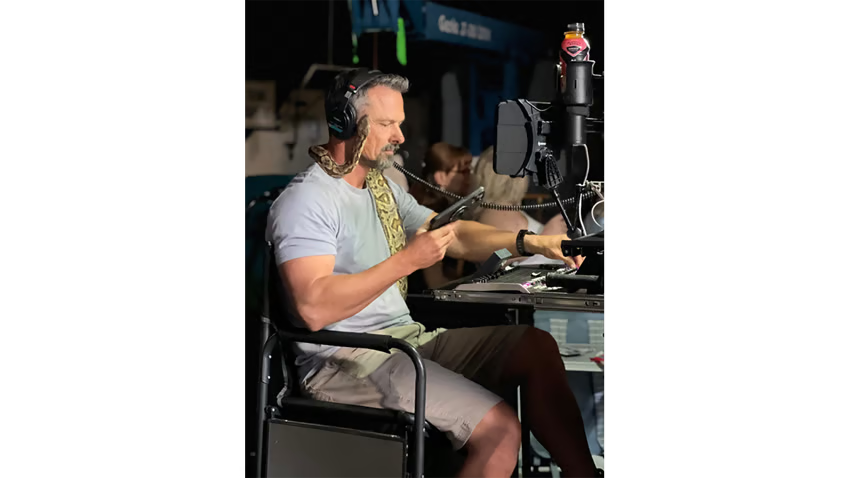There is no denying that technologies are evolving to redefine artistic boundaries for lighting designers, and institutions like the University of Maryland (UMD) play a crucial role in providing gateways for students to research, explore, and discover such technologies, including BT-1 (BlackTrax One). Five Twelve Marketing recently sat down to speak to Luis Garcia and Jerran Kowalski, talented Lighting and Video Designers who recently utilized BT-1 to introduce real-time interactivity and immersion into the theater adaptation of ‘A Bicycle Country’.
Currently, in their final year of completing a master's degree, Luis and Jerran began to experiment with new, innovative technologies that would take the production of ‘A Bicycle Country’ beyond the traditional confines of theater. Having discovered CAST Group of Companies educational program, the university was able to access a loaner system of BT-1 that not only infused the production with new creative avenues but helped the duo achieve their aspirations of expanding their expertise and portfolio in the realm of real-time tracking technologies, with a specific focus on BlackTrax.
Luis commented, “Exploring new technologies and artistic ideas is deeply ingrained within the University. Having first witnessed BT-1 in action at LDI in 2018, I was instantly intrigued by the possibilities of tracking and interactivity, and it has stuck with me ever since. When the opportunity arose to incorporate BT-1 into a production as part of my thesis, I jumped at the chance. Thanks to CAST’s Education program, along with the University's encouragement, it’s incredible not only to learn the technical aspects of our craft but to go beyond that and grapple with new cutting-edge technologies before even graduating.”
Written by Pulitzer Prize-winning playwright, Nilo Cruz, ‘A Bicycle Country’ unfolds in two acts:
- Act 1: Set in Cuba during the aftermath of the Cuban crisis, the first act explores the challenges faced by people coping with a crashed economy and introduces three friends who are determined to leave their country and start a new life in America.
- Act 2: Set entirely in an open ocean on a makeshift raft, this act delves into the uncertainties during their perilous journey to America, and explores the effects this has on their wellbeing.
“In the early stages of conceptualizing Act 2, director Fatima Quander expressed a keen interest in exploring the minds of the characters and how to animate hallucinations in a theater environment. Knowing that this act was set in an ocean instantly drew us to the idea of integrating interactivity to make the water react with the talent in real time. The connection between reality and fantasy was crucial to the narrative, and that’s when the concept of using BT-1 began to take shape.” stated Luis.
Aware that Act 2 presented unique challenges due to the narrative, Luis and Jerran decided to experiment using BT-1, with the hope of creating a dynamic and responsive environment that activated the world in a way that went beyond a simple projection; something that the University had not yet seen. As the act was also predominantly set at night, the team projected time-lapse transitions from night to day and back to night on the backdrop and the floor of the production and used BT-1 to synchronize the water's movements with the actors on the raft in real-time. The floor acted as a mirror reflecting the sky and featured stars that interacted realistically with the waves of the ocean and the movement of the raft.
The technical implementation of BT-1 was led by Jerran who used four beacons to activate the environment in a new way: A mini-beacon was placed on the mast of a rotating platform that represented the raft, spinning around the stage throughout the entirety of the performance. This allowed the team to create realistic water trails as it pivoted. Three beacons were then placed, one on each character along with a stringer on each shoulder to track the movements of the raft and the actors, and also connect them. At only one point in the production does an actor step out of the boat, triggering bioluminescent effects resembling algae, creating a visually stunning path as they move across the stage.
Jerran commented, “Using the XYZ tracking sent to TouchDesigner along with velocity we were able to alter the acceleration of the beacons. This information provided the necessary control over the automation points enabling the team to manipulate the content projected (water trails and interactive waves) onto the stage and synchronize it with the movement of the entire production. For example, the shoulder-mounted beacons placed on the talent responded to the rowing movements of the characters, triggering reactions in the water based on sudden drops in Y values. The ability to activate content was a dream for us as video and lighting designers. It was a true learning journey that elevated the production and took the story to a whole new level of artistic expression, and it was incredible to see it come together in the way that it did.”
“The benefits of BT-1 on the production were truly transformative, especially from the perspective of a video designer. One significant advantage was the considerable time saved during tech rehearsals. Once the BlackTrax sensors were hung and calibrated, assigning files to beacons hugely simplified our workflow. For instance, placing a black shape over the boat didn't require programming cues for every turn; the assigned beacon ensured automatic movement, enabling us to focus on other important aspects of the creative process,” commented Jerran. “From a media perspective, the interactivity breathed new life into the content, transforming it from a static 2D image to a dynamic 3D reality and facilitated organic interactions, which resonated with the audience. Furthermore, the actors could physically see how the virtual environment responded to them. It gave the talent a further sense of ownership, responsibility, and immersion in the story, allowing them to connect deeper with the narrative and the world they inhabited. There’s no denying that BT-1 not only streamlined our technical processes but also enriched the production with a level of interactivity that fundamentally changed how our story was told, received, and experienced.”
Reflecting on the transformative journey with BT-1, both Luis and Jerran emphasize the importance of schemes like CAST’s educational program. “Having the ability for universities and students like ourselves to be able to access and experiment with BT-1 is truly unique and it will surely help prepare us for the professional world. From this one project, the enthusiasm and curiosity among peers has skyrocketed with many wanting to integrate the technology into their own projects.”
Luis Garcia and Jerran Kowalski's innovative use of BT-1 in ‘A Bicycle Country’ production in an educational setting shows how CAST has brought a new level of lighting, media, and audio automation to creatives, and now universities, that may have previously considered this technology beyond their reach.
This successful application of cutting-edge technology not only serves as a testament to the University of Maryland's commitment to providing a platform for creative exploration and learning but also highlights how important it is to open doors for the next generation of lighting and media designers to easily access live event technologies that are dominating the industry. We are extremely excited for Luis and Jerran as they begin the next step in their career, and we look forward to following their journey over the next few weeks, months, and years to come.
Off
More News
Support USITT
For many 501(c)3 nonprofit organizations, USITT included, donations are a lifeline. We are able to continue to expand our online offerings to our Members and to our industry thanks to Membership dollars and the generosity of our donors.







